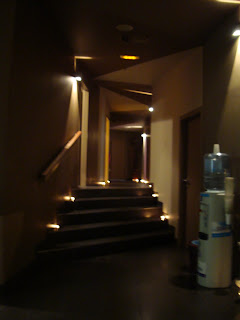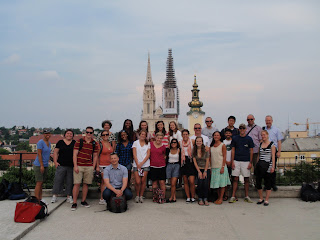The agenda for today included a lecture at the hotel, a walk to the Croatia National Archives where we attended a lecture and took a tour of the building, a trip to the University of Zagreb Faculty of Agriculture to attend a lecture and to visit the vineyard and wine experiment station, followed by a visit to the Croatian Auto Club.
During class, we discussed primary health care and the impact of poverty and culture on health. Historically, primary health care was not part of health until after World War II when there was an influx of soldiers with physical injuries and mental health problems resulting from the war. The World Health Organization focused on the need for primary health care in rural areas due to the gap in health indicators based on poverty and wealth status, with poverty being prevalent in rural areas. The goal was to build hospitals and provide services in these areas of economic hardship to reduce the health disparity gap between the wealthy and poor.
These changes, along with the innovations in health care discussed in a previous posting resulted in a demographic transition in society. In areas of low SES, there was limited population growth due to high fertility and mortality. Research has shown that an individual living in poverty loses 10 years from their expected life span as a result of their SES. There are various causes for this, which are lack of safe and adequate housing, consuming spoiled food or contaminated water, malnutrition, and lack of access to health services, education, resources and status. As medical innovations were introduced to fight infections, increase sanitation and allow individuals to control their own fertility, there was a shift to low fertility and low mortality rates in areas of higher SES. The demographic transitions required new resources and policies to be developed to care for the changing society. Finally we discussed the role of culture on health, which is the shared beliefs, meanings, ideas, and values of a group of people. We compared and contrasted the culture in the United States with Croatia.
After the class meeting, we walked to the Croatia National Archives where we attended a lecture on the Croatian Heritage Strategy by Dr. Jadran Antolović. This lecture was followed by a guided tour of the Archives. The building was a beautiful home for historical documents important to the culture of Croatia. These relics were surrounded by beautiful, ornate paintings and mosaics, as well as magnificent stained glass in the windows and ceiling, which are pictured above. Once the tour ended, we walked to lunch as a group and dined on another delicious four course meal of local cuisine.
After lunch we boarded our purple chariot and traveled a short distance to the University of Zagreb, Faculty of Agriculture. We attended a lecture on Croatian agriculture (pictured above), followed by a visit to the vineyard and wine experiment station. Here we toured the facility, including the wine cellar where the wine was produced and aged before bottling for distribution to the local area.
At the end of the tour, the group traveled to the Croatian Auto Club where Mr. Alan Vojvodić discussed the auto club and traffic safety issues in Croatia. Examples of antique vehicles were displayed in the lobby, and are pictured above. Traffic safety began in London in 1896 after Bridget Driscoll was killed by a vehicle. The police investigating this crash wanted to prevent future injuries and deaths, so they started to develop procedures to enhance road safety. Even though the concept of traffic safety began over 100 years ago, there is still a major problem with regards to injury and death related to vehicles. WHO determined in 2005 that traffic crashes are the tenth leading cause of death worldwide. It is estimated that by 2030 traffic crashes will move up to the fifth leading cause of death worldwide. This will primarily occur in areas of poverty, where there are inadequate roads and equipment. Three primary strategies were defined to help combat this problem, which are providing emergency assistance, increasing road safety, and developing and enforcing legislation related to traffic safety. In 2010 the United Nations declared the next 10 years as a “Decade for Action” for road safety with the goal of stabilizing the number of road crashes. It is projected that if 50% fewer people die as a result of a crash over the next decade, that one million lives will be saved by 2020.
Currently in Croatia, laws and guidelines are established to promote safe driving. The minimum age to get a driver’s license is 18 for a car, and 16 for a motorcycle. There are laws in place regarding drinking and driving, as well as the use of cell phones while driving. Safety belts are required to be worn in both the front and back seats, and children are required to be in child safety seats until they reach a specific weight. Current preventative measures include providing driver education, safer vehicles and technology, and safer and forgiving roads. Trend data reveal an overall reduction in deaths, and the goal of no more than 10 per 100,000 deaths per year as a result of a car crash has been achieved. Even though all of this is in place, as mentioned in yesterdays post, there are safety issues on the roads in Croatia, making them a risk for crashes. In the city, roads are shared by vehicles, trams and bicycles, as well as pedestrians. While observing the flow of traffic, it appears to be organized chaos. Everyone seems to know how to navigate the roads to avoid a crash. I feel this may not be the case if an inexperienced driver or someone like us from another country tries to navigate the city. It would be stressful to be driving a city street in Zagreb to look up and see a tram in your back window, right behind you. Mr. Vojvodić stated that this could be rectified by restricting cars from driving on city streets; basically requiring them to park at the edge of town and riding transit into the city. This would simplify the traffic in the city dramatically, ultimately reducing the risk for traffic crashes. Overall this was a great day, packed with great lectures and experiences. I cannot wait for what tomorrow brings!













































